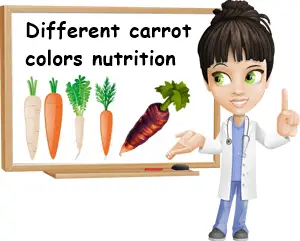Many people assume the original carrot color is orange, when in fact all the different carrot colors available nowadays come from one common, colorless ancestor, the wild carrot (Daucus carota). Once domesticated, the former wild carrot has been subjected to artificial selection that resulted over time in all the different carrot colors we see today. Red, pink, purple, black, yellow and cream are not only natural carrot colors obtained through artificial selection over the course of hundreds of years, but also indicators of nutritional diversity and sources of varied health benefits.
Carrot color history
The modern domesticated carrot was commonly cream colored and naturally evolved to have purple roots. The whole purple carrot is believed to have evolved from it. Yellow carrots appeared at around the same time and were essentially purple carrots with a recessive gene. In other words, yellow carrots were actually purple carrots that suffered a natural mutation that caused them to lose their pigment. So the first domesticated carrots were cream, then purple and yellow and are considered by some to be the original modern carrots. Sometime around the 17th century, orange carrots were introduced into the Netherlands by the Dutch and have gained immense popularity, currently being the most well-known varieties.

Orange carrots presumably originated from the yellow variety. According to some, red carrots have evolved from orange ones, although it has been advanced that they were also developed from yellow carrots around the same time as the orange varieties. Some experts consider the cream, purple and yellow carrots to be the original Eastern varieties, while the orange ones to be the original Western variety. And now trends are shifting, with the orange carrots becoming popular in the East and the purple carrots becoming more popular in the West. But most important, each color indicates a change in nutrient composition, notably antioxidant profile.
Pigmentation and nutrition
Each pigment has been carefully developed to obtain more attractive vegetables. At the same time, it resulted in an increased nutritional value. More exactly, while the vitamins and minerals content (with the exception of vitamin A), dietary fiber, carbohydrate, protein, fats, sugars profile and energetic value are more or less the same in all varieties, antioxidant profiles differ. Different varieties of carrots are a great source of the following antioxidants:
– Orange carrots: highest in beta-carotene, contain smaller amounts of alpha-carotene, gamma-carotene, lutein, zeaxanthin.
– Purple carrots: highest in anthocyanins, also contain beta-carotene and alpha-carotene and small amounts of lutein and zeaxanthin.
– Purple carrots that are orange inside: high in anthocyanins, beta and alpha-carotene.
– Purple carrots that are red inside: richest in anthocyanins and lycopene.
– Purple carrots that are white inside: anthocyanins, little beta-carotene.
– Red carrots: highest in lycopene, also contain smaller amounts of lutein, beta-carotene, alpha-carotene.
– Yellow carrots: highest in lutein, may also contain zeaxanthin.
– White carrots: no pigment-giving antioxidants.

According to a study called Comparison of Volatiles, Phenolics, Sugars, Antioxidant Vitamins, and Sensory Quality of Different Colored Carrot Varieties, purple varieties with orange core have more than two times more alpha-carotene and beta-carotene than orange varieties. This may not be true for all cultivars and factors such as soil quality, pigment depth and others may seriously alter nutritional profile, but if you want to choose the best carrot color for you, then this is a great guideline to antioxidant content.
Orange carrots vs purple (black) carrots nutrition
Since these two are the most widely consumed varieties at the moment, it’s only normal to want to know which of the two is healthier. Based on known nutritional facts and extrapolating from existing studies, it would seem that purple carrots with orange core are the healthiest, followed by entirely purple carrots and then orange carrots. Some experts consider purple and orange carrots to be just as healthy, while others think orange are better than purple (see Properties and Benefits of Black Carrots).
The differences in opinion regarding which carrots are healthiest can be explained by the fact that each class of antioxidant pigments (carotenes vs anthocyanins) provides different benefits. Simply put, a person deficient in vitamin A will benefit more from eating orange carrots or purple carrots with orange core. But a person who wants to include more anthocyanins in their diet and enjoy stronger anti-inflammatory benefits may be advised to choose purple carrots over orange ones. So you can say both carrot colors are healthiest, depending on what benefits you are looking to obtain.
Which carrots are good for eyes?
This is an interesting question since not one, but several varieties are good for our eyesight and combined provide the most benefits for vision. You actually need beta-carotene and alpha-carotene from orange varieties and purple ones to make vitamin A for eyesight. Yellow carrots contain lutein which is absorbed in macula lutea area in the retina where it contributes to eye health. You also need anthocyanins from purple varieties to enjoy anti-inflammatory benefits and lycopene from red carrots to protect the retina against free radicals from light (see Properties and Benefits of Red Carrots) .
Other nutritional differences
Different studies on cultivars of various colors revealed there may be significant nutritional differences between carrots. For example, yellow and white carrots are typically low in vitamin A because they lack the carotenes that are converted into the vitamin. Studies show the most abundant mineral in all colors is potassium at 443-758 mg per 100 g of fresh root (Genetic variability influences carotenoid, vitamin, phenolic, and mineral content in white, yellow, purple, orange, and dark-orange carrot cultivars).
Calcium levels are steady in all cultivars, whereas zinc, manganese and copper levels fluctuate depending on cultivar and factors such as soil quality. The orange varieties are estimated to have the highest mineral content. Fiber content may differ between cultivar and be influenced by age of root at the time of harvest: 2.4 to 6.4 g of dietary fiber/100 g of carrot root. What stays unchanged is the higher insoluble vs soluble fiber ratio, with most cultivars having over 50% insoluble fiber. The older the carrot, the woodier its texture and the higher the insoluble fiber content (some roots may have up to 90% insoluble fibers). The younger roots may have up to 50% soluble fibers, including pectin, responsible for the anti-diarrhea effects of carrots.
Lastly, the darker the color, the higher the antioxidant content. For example, dark orange carrots may have over 80% alpha and beta-carotene, whilst lighter-colored orange roots may have less than 40% pro-vitamin A antioxidants (study: Carotene in typical and dark orange carrots). This also means that purple-black carrots are richest in antioxidants and, from this point of view, the healthiest of all colors. They are followed by dark red, red orange, orange, yellow and white cultivars in roughly this order. All varieties are high in chlorogenic acid of all antioxidants and contain varying amounts of other phenolic compounds, notably flavonoids (Evaluation of different colored carrot cultivars on antioxidant capacity based on their carotenoid and phenolic contents).
Carrots trivia
Here are some facts to make you an expert on the root vegetable:
1) Original wild and domesticated carrot color was cream-white (like parsnip).
2) Touching wild carrots caused burning sensation, itching, redness and blisters on skin.
3) Wild carrots look similar in appearance to hemlock.
4) You could only eat very small amounts of wild varieties because they were mildly toxic.
5) Wild carrots had a long, but very thin root which often grew to become too woody to eat.
6) All modern varieties actually have little alpha-carotene and more beta-carotene, irrespective of their color.
7) You need to cook all carrots to be able to assimilate most of their nutrients.
8) To absorb carotenes and be able to get vitamin A from some of them, you need to eat carrots with a source of fat. You need to cook and combine red carrots with fat to assimilate lycopene.
9) Carrots do not contain real vitamin A, but rather carotenoid antioxidants which are converted into vitamin A.
